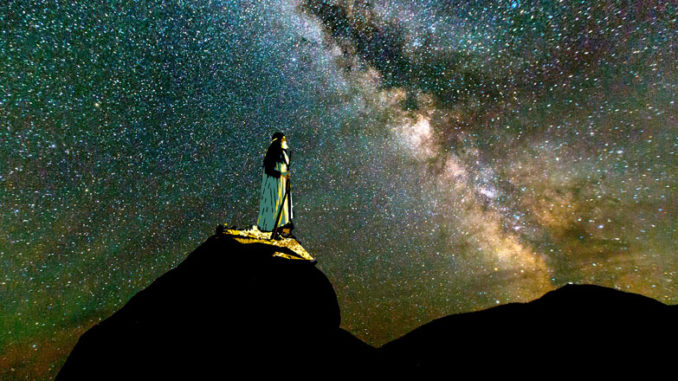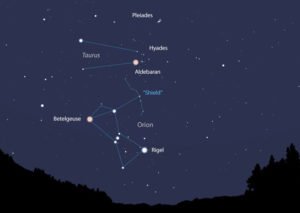
“THE HEAVENS DECLARE THE GLORY OF GOD.” – Psalm 19:1a
Commentary by W. Thomas Smith Jr.

I LOVE THE NIGHTTIME STARS, always have. If nothing else, stars remind me of James 1:17, which says, “Every good thing given and every perfect gift is from above, coming down from the Father of lights with whom there is no variation or shifting shadow.”
Stars for me are an absolute manifestation of the supreme power of God: His art, His perfect orderliness, and His constancy. The stars in their movement are like a giant clock that never needs winding. God did this, I believe, for us. But my appreciation for this fact has been a journey.
My fascination with stars probably began as a Cub Scout during a rare camping trip when we “cubs” paired up with a Boy Scout troop (actually a “patrol” as I recall) and ventured somewhere far out in the country along the Wateree River in Kershaw County, South Carolina. This would have been about 50 years ago now, but I remember us darting around in a big multi-acre field surrounded on all sides by miles of piney woods playing “flashlight tag,” running and laughing until we could barely catch our breath. After awhile we collapsed and rested on our backs for about an hour in the cool grass and looked up at what appeared to be a zillion stars in the clearest blackest sky. The scoutmaster, Mr. Frierson, a retired Army officer, pointed out a lot of the constellations.
Though difficult to make out the various animal-and-other shapes in the sky – everything from the Great Bear to Leo to Perseus to Auriga – that particular overnight outing observing the vast starry sky impressed me far more than the field trips my elementary-school class sometimes made to the local planetarium. Though those too were exciting.
I recall, also as a kid of about eight-years-old, my dad and I standing in front of the Villa Tronco Restaurant in my hometown of Columbia, S.C. It was a few nights before Christmas, and I was looking west down Blanding Street and up into the black sky where I saw a very bright star. I told Dad it might be what the wise men had seen. He agreed. We stood there a few minutes in the cold looking at the star and talking about it before we got in the car and headed home. It probably wasn’t the Bethlehem star, but it is a great memory.

Many years later in college, I took two semesters of astronomy as part of my physical science requirement studying the make-up of the planets, the relative size and composition of the stars (mostly hydrogen and helium), and the distances primarily measured in light years from Earth to all things visible in the heavens. But that didn’t aid as much in my love of stars as it did help me better understand the nature of them.
Then in the Marine Corps during land-navigation training followed by real-world practical application, I learned much about how to navigate across great distances at night using key stars and various constellations as guides; a skillset that benefits me even today.
Stars and constellations have always been an important part of Marine Corps land-nav work, as well as seaborne and ground operations; even the unique culture of Marine infantry and special operations forces wherein the official patches of the 1st Marine Division (the division in which I served) and the Marine Raiders have always featured five bright-white stars in the arrangement of the Southern Cross constellation on a nighttime sky-blue background. The constellation was visible to the division’s men who were fighting on Guadalcanal during World War II: A truly stellar heritage which all Marines embrace.
I also remember the grandeur of starry nights at sea aboard ship in zero exterior-light conditions; and – probably like so many Marines and sailors before or since – penning poetry about the stars for a girlfriend back home.
Years beyond innocency: following marriage and a heart-wrenching divorce; broken dreams; the loss of my father, my brother and others; the experiences of war; and the myriad other tragedies of life most of us have or will have experienced in varying degrees; I’ve always derived great comfort in waking up at 0-dark-thirty and rushing outside to witness the glory and majesty of God in His creation; the fixed stars, the shifting planets, and the moon in its varying visible configurations even if only for a minute or two before going back to bed.
I’ve always loved the stars. In some form or fashion they’ve always been part of my life, but perhaps not as richly and as meaningfully as they are today.
My recently renewed fascination with stars was piqued several years ago as I began to delve deeper into God’s Holy Word. The Bible is quite literally filled with references to stars from Genesis to Revelation; and the oldest book in the Old Testament, Job, mentions three of the very constellations I gazed upon last evening as I decided to write this.
Among the rhetorical questions asked in the book of Job are, “Who made the Bear and Orion, the Pleiades and the chambers of the south?”
The Great Bear of which the northward-leading Big Dipper is a part, the hunter Orion with his easily recognizable belt of three stars, and the faint albeit magnificent Pleiades all rose and set above my house last night. And I thought about Job and God as I looked at them.
These exact same constellations – ever-revealing God’s unchanging nature, His utter constancy and infinite, eternal power – were also seen by the Biblical patriarchs Abraham [depicted above], Isaac, and Jacob. And yes, Christ Himself, who as God, made the Heavens.
And that’s where and how the grandness of the stars so appeals to and blesses me. The stars are reminders that we are to hang on, no matter what. Cling to God. Have faith in Him. Believe against all whispers of unbelief.
Almighty God – Father, Son, and Holy Spirit – made the Heavens, “the Heaven of heavens with all their host,” as we read in the book of Nehemiah. Then the Gospel writer John tells us, “All things came into being through Him, and apart from Him, nothing came into being that has come into being.”
That’s not all. Included among the many Scriptural references to stars, we have the elusive Bethlehem star, which I mentioned having considered at least as young as eight-years-old. We really don’t know what that star was. But we do know that the magi – presumably Persian or more specifically Babylonian court advisors, alchemists, astronomers, astrologers (yes, astrology being a discipline we should shun) and widely held to be experts in the reading of ancient manuscripts – saw a particular star rising in the east, which led them west to Jerusalem and the court of Herod, then south to Bethlehem.
The magi were searching for and ultimately found the Jewish Messiah. It is all beautifully recorded in the second chapter of Matthew, and nowhere else in Scripture.
Was the star a conjunction between two or more planets? Maybe. Was it a meteor (what we sometimes refer to as a shooting star) or even a comet? Highly unlikely. A nova or a supernova? Perhaps. Was it an angel or a company of angels that appeared as a bright star to the magi as some have suggested? What about the inexplicable manifestation of the Shekinah glory of God? We simply don’t know.
What we do know is that it was something that the magi witnessed as a star rising in the east, which is the direction from which the fixed stars have always risen and always will.
The story of the magi and the Bethlehem star has added yet another element to my lifelong fascination and history with the stars. And the magi story combined with the many references to stars and constellations throughout Scripture again reminds and comforts me in the knowledge of what we read in Isaiah 45, “I made the earth and created man on it; it was My hands that stretched out the heavens, and I commanded all their host.”
So if it is a clear night, dress warm, go out and enjoy “the heavens” and “all their host.” It’s one of God’s many gifts to us. And like Him – and as reminders of His imponderable power and unalterable glory – His stars will always be there.
– W. Thomas Smith Jr. is a New York Times bestselling editor and military technical advisor. Visit him online at uswriter.com.
